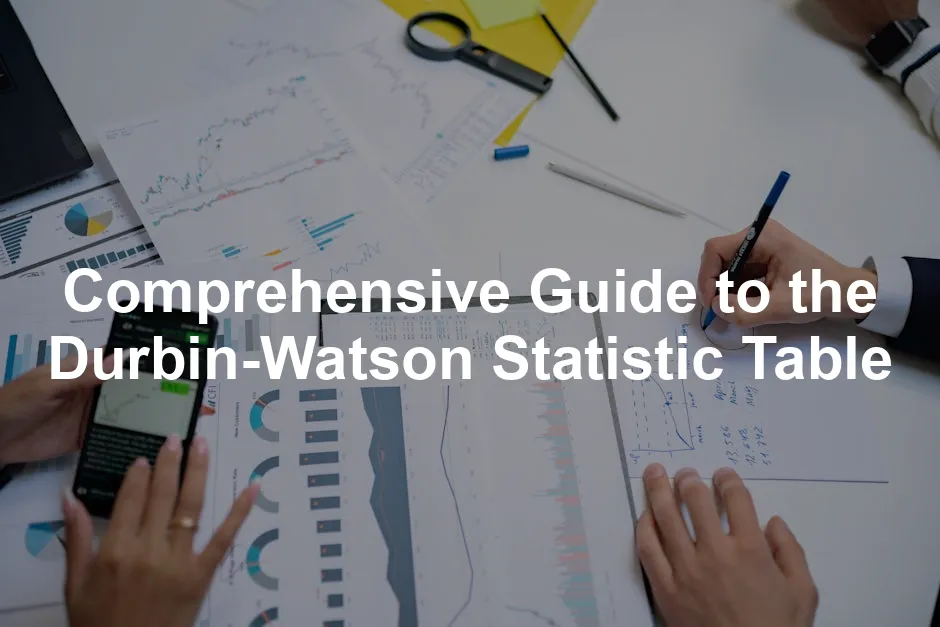Introduction
The Durbin-Watson statistic is a vital tool in regression analysis. It tests for autocorrelation in the residuals of a regression model. Autocorrelation occurs when the error terms are correlated across observations, which can lead to misleading results. By identifying this correlation, researchers can ensure the reliability of their regression models.
This blog post aims to shed light on the Durbin-Watson statistic table. We will cover how to interpret this table, the methods to calculate the statistic, and its significance in detecting autocorrelation. Understanding these elements is crucial for any data analyst or researcher who aims to create robust statistical models. Whether you’re a seasoned statistician or a curious beginner, this guide will equip you with the knowledge to navigate the intricacies of the Durbin-Watson statistic and its table effectively.
While you’re diving into the world of statistics, why not keep your workspace comfortable with an ergonomic office chair? It can help you focus longer without the nagging back pain!

Understanding the Durbin-Watson Statistic
What is the Durbin-Watson Statistic?
The Durbin-Watson statistic (D) ranges from 0 to 4. A value near 2 suggests no autocorrelation. Values closer to 0 indicate positive autocorrelation, while those nearing 4 suggest negative autocorrelation. This statistic is essential for assessing the independence of residuals.
Autocorrelation is a statistical phenomenon where the residuals from a regression analysis are not independent. This can occur in time series data, where current observations are influenced by past ones. For instance, stock prices today might depend on prices from previous days. If autocorrelation exists, it can lead to inaccurate estimates of coefficients and inflated statistical significance.
To help you with your data analysis, consider grabbing a statistical software package. It can simplify your calculations and make your life a whole lot easier!

Importance of the Durbin-Watson Test
Detecting autocorrelation is crucial in regression analysis. If autocorrelation exists, it violates one of the key assumptions of ordinary least squares regression. This can lead to misleading results, making it seem like certain predictors are significant when they are not.
Consider a scenario involving economic data over several years. If you analyze annual GDP growth, each year’s growth might depend on the previous year’s performance. Here, the Durbin-Watson test helps identify any underlying autocorrelation, which can skew your results and conclusions. By addressing this issue, you enhance the reliability of your model and its predictions.
In summary, the Durbin-Watson statistic is a powerful tool for ensuring the integrity of regression analysis. It highlights the importance of understanding autocorrelation and its potential impact on statistical conclusions. Whether you’re dealing with time series data or other forms of regression, utilizing this statistic can safeguard against common pitfalls in data analysis.
Speaking of safeguarding, how about a data backup solution? Losing your research data can be a nightmare, so take precautions!

How to Calculate the Durbin-Watson Statistic
Step-by-Step Calculation Process
Calculating the Durbin-Watson statistic isn’t just a walk in the park, but don’t worry! With this simple guide, you’ll be crunching numbers like a pro.
1. Set Up Your Regression Model: First, you need a regression model. This could be simple or multiple linear regression. Let’s say we have a model like this:
Y = β0 + β1X1 + β2X2 + … + βkXk + ε
Here, Y is the dependent variable, X represents independent variables, and ε is the error term.
2. Calculate Residuals: Once you have your model fitted, compute the residuals. Residuals are the differences between the observed and predicted values of Y:
ei = Yi – Ŷi
Where ei is the residual for the i-th observation, Yi is the actual value, and Ŷi is the predicted value.
3. Compute the Durbin-Watson Statistic: Now, plug those residuals into the Durbin-Watson formula:
D = (Σi=1n-1 (ei – ei-1)2) / (Σi=1n ei2)
Here, D represents the Durbin-Watson statistic, and n is the number of observations.
4. Interpret the Result: The value of D ranges from 0 to 4. A value close to 2 indicates no autocorrelation. Values below 2 suggest positive autocorrelation, while those above 2 indicate negative autocorrelation.
For example, if your calculated D is 1.5, this points to potential positive autocorrelation. If it’s 2.8, you might be looking at negative autocorrelation.

And while you’re at it, consider investing in a calculator that can handle complex equations. It can save you time and reduce errors!
Using Software for Calculation
Now, let’s take a look at how you can compute the Durbin-Watson statistic using some popular statistical software. This will save you time and make your life easier!
R
In R, calculating the Durbin-Watson statistic is as easy as pie. Here’s a quick code snippet:
# Fit the linear model
model <- lm(Y ~ X1 + X2, data = your_data)
# Load the lmtest package
library(lmtest)
# Calculate Durbin-Watson statistic
dw_statistic <- dwtest(model)
print(dw_statistic)
Make sure you have the lmtest package installed to run this code successfully.

If you’re looking for a good book to deepen your understanding of R, check out an R programming book that can guide you through your statistical journey!
Python
For Python enthusiasts, here’s how you can do it using statsmodels:
import statsmodels.api as sm
# Fit the model
model = sm.OLS(y, X).fit()
# Get the Durbin-Watson statistic
dw_statistic = sm.stats.durbin_watson(model.resid)
print(dw_statistic)
This snippet will help you find the Durbin-Watson statistic with just a few lines of code. For more about using Python for statistical learning, check out an introduction to statistical learning with Python book length.
SPSS
In SPSS, follow these steps:
- Go to Analyze > Regression > Linear.
- Select your dependent and independent variables.
- Click on Statistics, check the box for Durbin-Watson, then click Continue and OK.
SPSS will include the Durbin-Watson statistic in the output table for you.
Minitab
If you’re using Minitab, here’s how:
- Navigate to Stat > Regression > Regression > Fit Regression Model.
- Choose your response and predictor variables.
- Click on Results, and ensure to check the Durbin-Watson statistic box.
Minitab will display the statistic in the output.
With these simple steps, you can calculate the Durbin-Watson statistic using different software. Now you’re ready to tackle autocorrelation with confidence!

The Durbin-Watson Statistic Table
Overview of the Durbin-Watson Table
The Durbin-Watson table serves as a crucial reference for interpreting the Durbin-Watson statistic. Structured neatly, it lists critical values based on sample size and number of independent variables in your regression model. Understanding how to use this table can make or break your regression analysis!
Typically, the table provides lower (DL) and upper (DU) bounds for different significance levels, such as 0.01 and 0.05. If your calculated Durbin-Watson statistic falls between these values, it indicates inconclusive results. For example, if your D statistic is below DL, you have positive autocorrelation. Conversely, if it’s above DU, there’s no autocorrelation.

If you want to keep your materials organized while studying these concepts, consider a document organizer to manage all your notes!
Significance Levels
The significance levels in the Durbin-Watson table are pivotal. They help assess the strength of the evidence against the null hypothesis of no autocorrelation.
– 0.01 significance level: This indicates a strong threshold for rejecting the null hypothesis. If your statistic falls below DL at this level, you can confidently assert positive autocorrelation.
– 0.05 significance level: This level is more lenient. If your statistic is between DL and DU, the results are inconclusive, meaning more investigation is warranted.
Understanding these nuances allows you to tackle your regression analysis like a seasoned pro. So, next time you face the Durbin-Watson statistic, you’ll know exactly how to interpret it using the table!
In summary, the Durbin-Watson statistic and its corresponding table are invaluable tools in regression analysis. With proper calculation and interpretation, you can ensure the reliability of your models, leading to robust statistical conclusions.

Interpreting the Durbin-Watson Table
Reading the Durbin-Watson table is like deciphering a secret code for regression analysis. This table presents vital critical values based on your sample size and the number of independent variables. Two key concepts here are DL (lower bound) and DU (upper bound).
When you calculate the Durbin-Watson statistic (D), you’ll compare it against these bounds. If your D value is less than DL, it signals positive autocorrelation. Conversely, if it’s above DU, no autocorrelation is present. If your statistic falls between DL and DU, the results are inconclusive. That’s right, the suspense continues!
For example, let’s say your sample size is 10 with two independent variables. According to the table, DL might be 1.5, and DU could be 1.8. If your calculated D is 1.4, you have positive autocorrelation. But if it’s 1.6, you’re in the unclear zone.
Understanding these bounds can save you from some serious statistical blunders. It’s crucial to keep an eye on the significance levels as well, typically 0.01 and 0.05, which influence how confidently you can reject or accept the null hypothesis.
Examples of Using the Table
Let’s sprinkle some real-world examples to illustrate this concept. Imagine you’re analyzing the impact of marketing spend on sales. You have 15 observations, and your regression model shows a calculated Durbin-Watson statistic of 2.2.
Referring to the table, you find that for 15 observations and two independent variables, DL is 1.2 and DU is 1.8. Since 2.2 is above DU, you conclude there’s no autocorrelation. High fives all around!
Now, picture a different scenario. You’ve got a sample size of 20 and a calculated statistic of 1.4. The table shows DL at 1.0 and DU at 1.5. Here, 1.4 lies between DL and DU. This inconclusive finding means you need to dig deeper—perhaps examining your data for patterns or other issues.
These examples highlight how the Durbin-Watson statistic and its table work together to guide your analysis. Understanding this tool helps ensure your regression results are reliable. After all, nobody wants to make decisions based on misleading data!

Limitations of the Durbin-Watson Test
The Durbin-Watson test is a go-to tool for gauging autocorrelation in regression analysis. But like that friend who always borrows your favorite sweater and never returns it, this test has its limitations. One major drawback? Sensitivity to sample size. If you have a small sample, the Durbin-Watson statistic can produce unreliable results. A statistic that might signal autocorrelation in a small sample may not hold up in larger datasets.
Another limitation is its dependence on the number of predictors. As the number of independent variables increases, the bounds for the Durbin-Watson statistic can change. This means that what might be considered an acceptable statistic in one model could signal issues in another. So, if your research involves multiple predictors, you might want to tread carefully.
In light of these limitations, it’s wise to consider alternative tests for autocorrelation. One popular option is the Breusch-Godfrey test. Unlike Durbin-Watson, the Breusch-Godfrey test can handle more complex models with lagged dependent variables. If you’re working with time series data or suspect more intricate autocorrelation patterns, this test might be your best friend. For more insights on effective data analysis, refer to tips for effective data analysis in economics and statistics.
And while you’re considering alternatives, you might also want to stock up on some statistical analysis books that can broaden your understanding of various methods!
In summary, while the Durbin-Watson test is useful, understanding its constraints helps researchers make informed decisions about their analysis.
Best Practices for Autocorrelation Testing
Recommendations for Researchers
When conducting the Durbin-Watson test, best practices can lead to more reliable outcomes. First and foremost, ensure your model meets the assumptions of regression analysis. This includes checking for linearity, homoscedasticity, and normality of residuals. If these assumptions are violated, the Durbin-Watson test results can become misleading.
Next, always inspect the residuals. Plotting the residuals against fitted values can reveal patterns that suggest autocorrelation. If you observe a systematic pattern, it’s a red flag indicating that autocorrelation might be present.
Furthermore, consider using the test in conjunction with other diagnostic tools. The combination of the Durbin-Watson test and other metrics, like the Breusch-Pagan test for homoscedasticity, can provide a fuller picture of your model’s performance.

When to Seek Alternatives
Understanding when to seek alternatives is crucial in regression analysis. If your dataset is large and you notice patterns in your residuals, it might be time to explore other tests. The Durbin-Watson test may struggle with large samples, leading to inconclusive results.
Moreover, if you suspect that the relationship between variables is not strictly linear or if you have lagged dependent variables, don’t hesitate to explore alternatives like the Breusch-Godfrey test. This test can accommodate more complex models and provide a clearer view of autocorrelation.
In addition, always assess the context of your model. The structure and nature of your data should guide your choice of tests. A thorough understanding of your data’s characteristics will enhance your analysis and lead to more accurate conclusions.
By adopting these best practices, researchers can ensure their regression analyses are robust and reliable, ultimately leading to better decision-making based on their findings.
Conclusion
In this guide, we explored the intricacies of the Durbin-Watson statistic and its critical table. We began by defining the statistic, emphasizing its range from 0 to 4 and its role in detecting autocorrelation in regression models. Autocorrelation can lead to misleading conclusions, making the Durbin-Watson test essential for robust analysis.
We discussed how to calculate the statistic and interpret the Durbin-Watson table, which provides critical values based on sample size and the number of independent variables. Understanding these values helps researchers discern the presence of autocorrelation, ensuring that their models are reliable and valid.
Ultimately, the Durbin-Watson statistic serves as a safeguard against erroneous interpretations of regression results. By applying this tool effectively, analysts can enhance the quality of their statistical findings and support sound decision-making in various fields.
FAQs
What does a Durbin-Watson statistic of 2 mean?
A Durbin-Watson statistic of 2 indicates no autocorrelation in the residuals of your regression model. In simpler terms, it suggests that the error terms are independent of one another. This is the ideal scenario, as it validates that the model’s predictions are not influenced by previous observations. If your value deviates from 2, it may suggest positive autocorrelation (values less than 2) or negative autocorrelation (values greater than 2).
How can I improve my model’s autocorrelation?
To tackle autocorrelation, you can try several approaches. First, consider adding lagged variables to your regression model, which may capture the influence of previous observations. Another option is to transform your data; for instance, using differencing can help stabilize the variance and eliminate autocorrelation. Additionally, applying robust standard errors can mitigate the impact of autocorrelation on your coefficient estimates, leading to more reliable results.
Can I use the Durbin-Watson test for non-linear models?
The Durbin-Watson test is primarily designed for linear regression models. However, it can still be applied to non-linear models to check for autocorrelation in the residuals. Just keep in mind that the interpretation might not be as straightforward. For complex relationships, consider using other tests, such as the Breusch-Godfrey test, which can handle more intricate patterns of autocorrelation.
What do I do if my Durbin-Watson statistic is inconclusive?
If your Durbin-Watson statistic falls between the lower bound (D_L) and upper bound (D_U), the results are inconclusive. In this case, you should investigate the residuals further. Plot them to identify any patterns. You might also consider adding additional predictors or transforming your data. If autocorrelation persists, exploring alternative tests like the Breusch-Godfrey test can provide clearer insights into your model’s performance.
Are there any software tools specifically for calculating the Durbin-Watson statistic?
Yes, several software tools can help calculate the Durbin-Watson statistic. Popular options include R and Python, which both have built-in functions for regression analysis. In R, the lmtest package provides the dwtest function. In Python, you can use the statsmodels library for a straightforward calculation. Additionally, statistical software like SPSS and Minitab also offer built-in features to compute the Durbin-Watson statistic within their regression analysis outputs.
Please let us know what you think about our content by leaving a comment down below!
Thank you for reading till here 🙂
All images from Pexels




